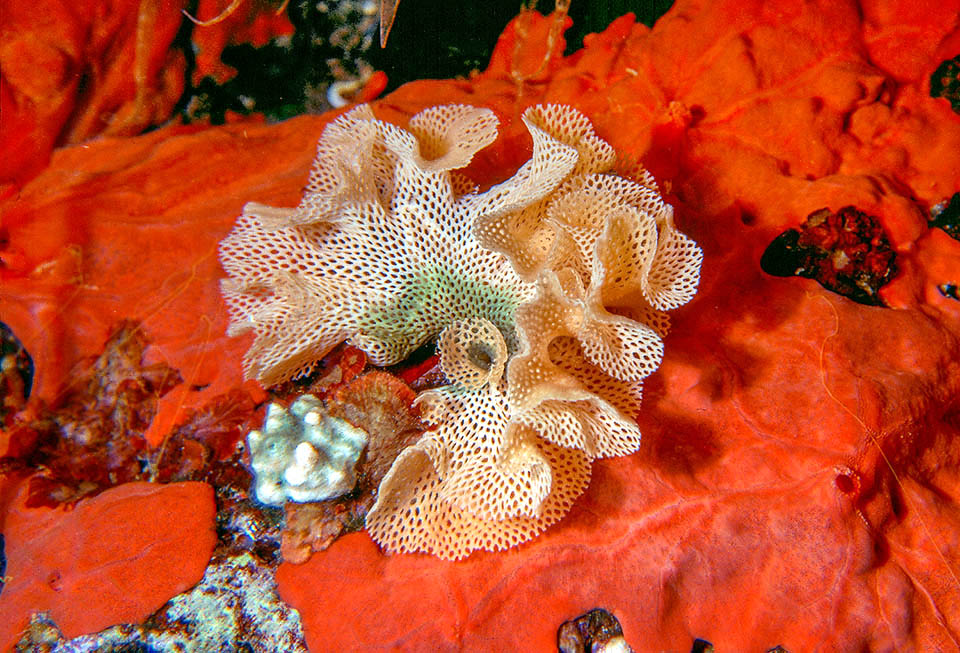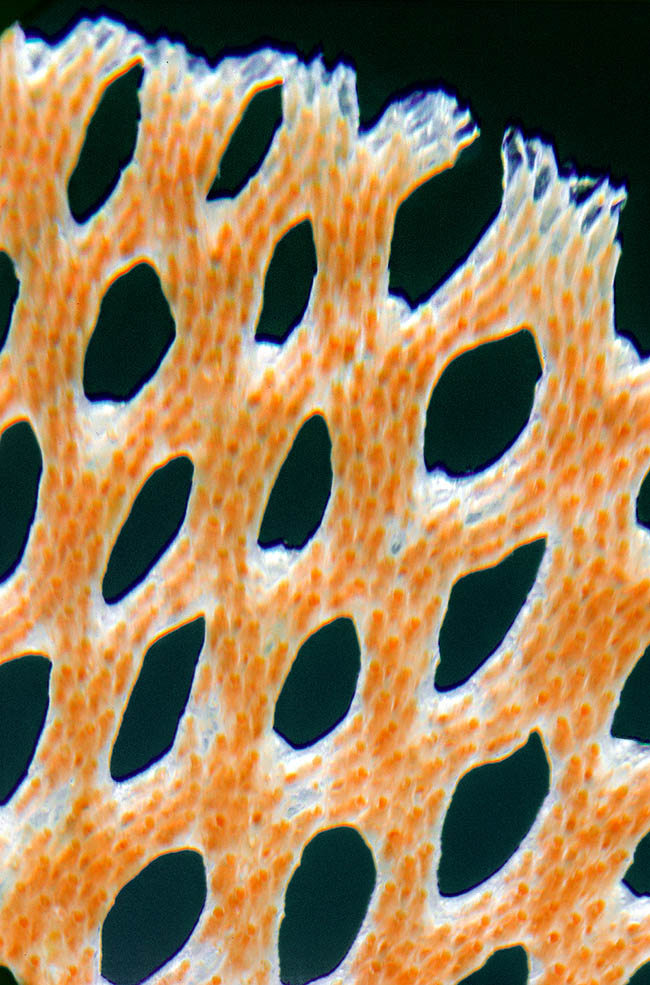Family : Phidoloporidae

Text © Prof. Angelo Messina

English translation by Mario Beltramini
Reteporella grimaldii (Jullien, 1903) is a genus of small aquatic invertebrates of the phylum of the bryozoans (Bryozoa) of the order of the Cheilostomatidi, diffused with about 150 species practically in all the seas of the Planet, including the polar ones. In the waters of the Mediterranean and of eastern Atlantic, Reteporella is present with various species, among which Reteporella grimaldii, considered the most beautiful, but also the most fragile of the Mediterranean.
In this regard, it should be specified at once that the taxonomic history of this species, like that of the genus to which it belongs, looks rather troubled in consideration of the fact that, due to evident uncertainties of diagnostic nature, in the past have been described as different species various forms, such as Reteporella septentrionalis, Retepora cellulosa, Sertella beaniana and Sertella septentrionalis, later on proved to have no specific validity and presently considered as synonyms of Reteporella grimaldii.
Sciaphilous and exclusively colonial form like other congeneric species, Reteporella grimaldii lives between 15 and 60 m of depth, fixed on hard bottoms, frequently on coralligenous. It loves environments with poor light and sheltered from the currents, like clefts or in zones in the shade of large submerged rocks or inside grottoes. It forms fragile “lace” colonies, usually 10-20 cm tall, of colour varying from salmon to pinkish and that get the look of a sort of rose formed by thin wavy and reticulated la true and real delicate lamellae that recall an embroidered lace with an exceptionally fine texture. For this reason, the species, very known by the divers who are attracted by its beauty, is commonly called with various names, such as Sea lace, Neptunes’ Rose or Neptunes’ lace.

The Sea lace (Reteporella grimaldii) is a colonial bryozoan, similar to a lace, frequent in the Mediterranean between 15 and 60 m of depth © Giuseppe Mazza
The fragility of the colony of Reteporella grimaldii does not recommend its collection because it fades quickly in the air, and only if handled with extreme care damages can be avoided, preserving its exceptional beauty. Unfavourable influences, such as variations in the availability of food, in the salt contents in the water, and in the temperature may alter the form of the colony.
The single individuals of the colony, called zooids, measure just half a millimetre and are all originated by adexual reproduction starting from a larva founder of the colony itself. The zooids live stuck through their basal part (cystid) to an elongated limestone case, called zooecium, that performs a protective function. The cystid represents the fundamental part of the animal as, besides secreting the zooecium, it has the function of regenerating the whole animal if necessary. Besides the cystid, that keeps permanently inside the case, the zooid is formed also by a forward portion that comes out, the polypide; this forms the mobile part of the animal as, if disturbed, can be quickly retracted inside the zooecium thanks to a retractor muscle and can be, later on, estroflected thanks to the action of parietal muscles. Each polypide contains the viscera and is provided of a typical structure, the lophophore, that all Bryozoans share with other phyla of invertebrates (Phoronids and Brachiopods), that for this reason are united in the group called of the Lophophorata or Tentaculata.
In Reteporella and in other marine Bryozoans, the lophophore is a raised crest annular in shape surrounding the buccal opening of the polypide on which stands a crown of small tentacles, furnished with cilia on their lateral surfaces.

Enlarged detail of Reteporella grimaldii. The colony of Sea lace is hermaphrodite with male and female individuals. From the fecundation that occurs inside this elegant structure, do originate microscopic larvae equipped with cilia that for some time lead a freely floating life. As soon as a larva finds a suitable substratum it settles on it and with repeated asessual reproductions by germination gives origin to a new colony © Giuseppe Mazza
The tentacles perform several functions, from that of feeding to that of breathing, to that of sensory function of perception of external stimuli. The colonies of Reteporella are polymorphic with variously modified zooids, among which we must remember the avicularia, with the characteristic shape of a beak of a bird, and the vibracularia, with the operculum elongated in a sort of whip.
Both types of zooids, who have lost the polypide and modified the operculum, perform the function to keep the surface of the colony clean and to hinder other organisms from settling over it. Detritivorous and microphagous like the other membres of the phylum, the Reteporella nourish of organic particles in suspension and of plankton, in particular bacteria, unicellular algae (Diatoms), and also of microscopic animals, such as Rotifers and larvae of crustaceans.
Thanks to the cilia of the lophophore’s tentacles, the zooids filter the water carried by the current and catch the organic particles and the predated microorganisms agglutinating them in a long cord of mucus that is dent towards the mouth; from this the cord with the caught microscopic preys passes through a short pharynx, then in the oesophagus to reach, through a valve, the U-bent stomach; from it the food reaches the intestine that ascends to the top to open above with the anus, sited close to the mouth itself, out from the crown of the tentacles.
Due to this peculiarity, the Anglo-Saxon Authors prefer to indicate the Bryozoans with the name of Ectoprocta. The digestion is partially intracellular and takes place inside alimentary vacuoles of the cells of the digestive tract.
Because of their microscopic dimensions, the breathing of these animals occurs through the surface of the body, especially that of the lophophore.
Like the other Bryozoans, the membres of Reteporella are also devoid of circulatory system but are provided of a simple nervous system; this is represented by a nervous perioesophageal cingulum placed under the lophophore, between mouth and anus; on the cingulum is inserted a cerebroid ganglion from which start the innervations that reach the tentacles and the other parts of the body.
In relation to their small size, these animals are also devoid of nephridia, and the function of excretion is done through the accumulation of granules of dark catabolites on the wall of the stomach followed by the periodical degeneration of the polypide and the formation of a small and characteristic dark irregular mass called “brown body”. The process, that is to be intended as a physiological response of the animal to the accumulation of waste substances, is completed with the regeneration done by the cystid of a new polypide; in turn, this expels the brown body eliminating in this way the catabolites previously accumulated.
The colony (zoarium) of the Reteporella is hermaphrodite with individuals of male or female sex and do not have genital tract. From the fecundation, that occurs inside the cavity of the body, develops a floating larva (cyphonautes), of conical shape and protected by a sort of thin coating or shell.
After having conducted free life, the cyphonautes settles on a substratum and, through a complex metamorphosis, transforms in the first individual of the colony, ancestrula, from which, after repeated sexual reproductions by germination, a new colony will happen.
